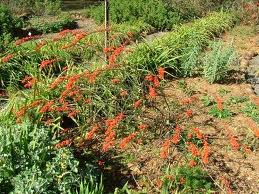|
These are hardy and tender, annuals and perennials that grow wild in various parts of the Northern and Southern Hemispheres. There are over 200 species, but comparatively few are grown in the garden. Those mainly grown range in size from the dwarf, compact annuals, which only grow a few inches high, to the perennials, which grow 3 feet or more high. The popular Lobelias that are used for summer bedding, have been raised from L. Erinus, a blue-flowered variety. The wild plant is straggling and grows about 6 inches high, but the varieties raised are compact and flower profusely in shades of blue, white, purple and crimson with white eyes. Even though they are perennials, they are grown as annuals. Perennial Lobelias are upright, thick stemmed plants. They produce rich green or crimson foliage and large flowers, usually bright scarlet, although there are now many varieties in pink and mauve hues and some have blue flowers. L. cardinalis (Cardinal Flower or Indian Pink) and L. siphilitica (Blue Lobelia) are tall growing, hardy plants that come from North America. They love wet soil and are great for watersides and wild gardens and for regular flower borders as long as the soil isn't dry. L. fulgens is a Mexican plant that isn't hardy in the North and won't thrive where summers are too hot. A variety of L. fulgens, the Queen Victoria, has reddish-crimson leaves and brilliant scarlet flowers. The varieties and hybrids of L. fulgens are true herbaceous plants that form growth at the base of the old stems during late summer; these provide the following year's plants. However, this kind of Lobelia is only hardy in the mild climates of the U.S., in many places, they need to be lifted and stored in a frost free greenhouse or frame.
Pot Cultivation
The tender perennials can grow in regular, well-drained garden soil. They prefer fairly cool summers and they'll stand light shade. The tall growing, perennial Lobelias need plenty of moisture and can be planted along the edges of pools and streams, though they must not be planted in boggy soil. They should be set 15 inches apart. They love deep, rich soil and if provided with this and plenty of water, will grow 3 feet or more high. L. cardinalis can be grown in pots and set in up to 3 inches of water. Since they are branching plants, if the central spike is removed as soon as it has finished flowering, the side shoots will continue to bloom well into late fall. Autumn is when they should be given dilute manure water or a good fertilizer. Plants that are grown in cooler climates should be provided with winter protection. Lobelias to be grown in baskets should be set in one that is lined with moss to hold the compost, which consists of loam and leaf mold. Turf is even better for lining than moss and provides additional rooting medium. The turf should be placed grass side inwards. Remember to water thoroughly when planting in a basket; the surface should be finished off slightly saucer-shaped. They can also be grown in a cool greenhouse or window garden (minimum temperature 50 degrees) in 6-inch pots. Hybrids and varieties of L. fulgens won't survive in harsh climates; in these places, the offsets need to be lifted and stored in a safe place during the winter.
Propagation
Seeds of the tender perennials (usually grown as annuals) may be started indoors (temperature 70 to 75 degrees), in flats that are filled with loam, leaf mold and sand, 8 to 12 weeks before they are to be set outside. The seeds are just sprinkled on the surface and left uncovered; they need plenty of light to sprout. As they are growing, lower the temperature to 45 to 50 degrees. The tall perennials can be increased by sowing seeds in early autumn or spring or by division at those same times. Division must be used when reproducing hybrids and garden varieties. When they are to be grown in the greenhouse, seeds may be sown in January or February in pots; they should be thinned and eventually placed separately into the 6-inch pots in which they will bloom.
 |
|
L. fulgens |
|
Varieties
- Hardy perennials -
L. cardinalis (Cardinal Flower or Indian Pink) L. siphilitica (Blue Lobelia);
L. fulgens.
- Those with colored foliage (Varieties of L. fulgens), which are only hardy in mild climates -
Queen Victoria; Blue Bird; Silver Queen; Delight; Purple King; Excelsior; Lady Gregory; Princess;
Mrs. Humbert;
Ibis; The Bishop; Elstead Scarlet; Huntsman; Arthur Humbert.
L. Erinus & varieties are good for growing in baskets.
L. tenuior (L. ramosa) is good for the greenhouse.
|